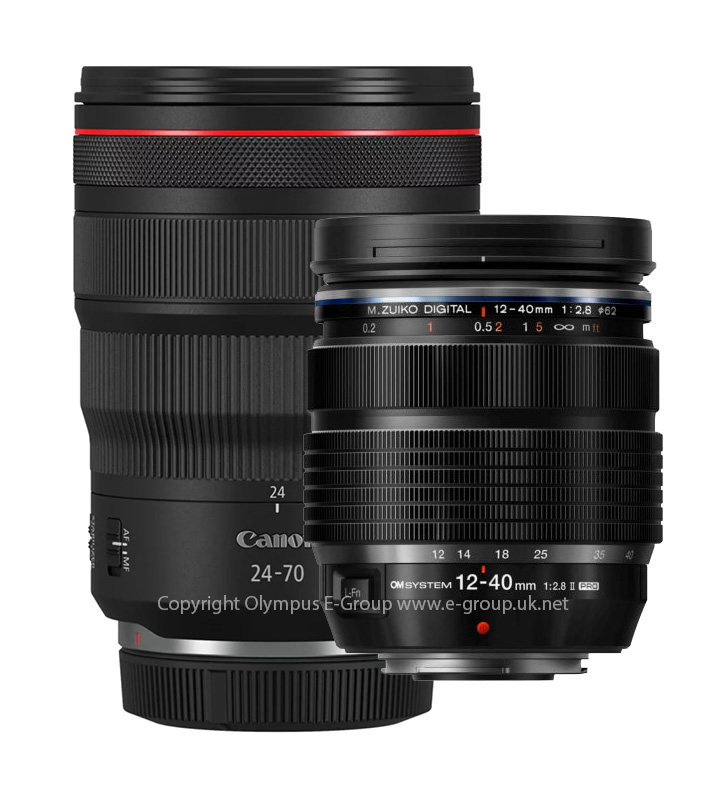
It’s very easy for photographers who are invested in relatively large sensor camera platforms to dismiss the smaller sensor Micro Four Thirds system. You might think it’s even easier now that the big hitters, Nikon and Canon, have finally retired their DSLR strategies, following Sony’s move a few years back. Without the need for space to house a mirror box and pentaprism viewfinder, they can now make much smaller and lighter camera bodies.
Mirrorless bodies can be very small, but what about the lenses?
Digital mirrorless system cameras, which Panasonic and Olympus ushered in 14 years ago, are generally much smaller and lighter than DSLRs. But it’s all very well making small camera bodies hiding large sensors; because sensor size dictates how large a lens has to be. APS-C and Full Frame systems still need lenses significantly larger and bulkier lenses than Micro Four Thirds. It’s one of the key reasons why photographers are switching to Olympus/OM System and Panasonic Lumix.
Larger sensor system lenses can be more compact but there is a cost
You can get lenses that are substantially reduced in size, but only by sacrificing the brightness of the optics. The Olympus m.Zuiko Pro 12-100mm f/4 is very similar in size and weight to Nikon’s Nikkor Z 24-200mm, which has the same viewing range and the same f/4 aperture at the wide angle end of the zoom range. But at 200mm, the Nikon lens is stopped down to f/6.3, 1.3EVs lower in brightness, while the Olympus lens retains maximum f/4 brightness across the zoom range.
An extreme example is Canon’s strategy of producing long telephoto lenses with f/11 fixed apertures. These RF 600mm and 800mm lenses are impressively small and light, but f/11 is a serious limitation to working brightness.
Mirrorless lenses are smaller than DSLR lenses
Mirrorless bodies bring the lens mount flange closer to the sensor focal plane. This helps reduce the size of lenses, too – especially with wide-angle lenses. So, some mirrorless lenses are now noticeably smaller than their DSLR counterparts. But sensor size is still the primary factor in determining the bulk of a lens.
Here are a few comparisons with similar Full Frame, APS-C and Micro Four Thirds lenses:
Nikkor (FF) S-Line 70-200mm f/2.8 vs. Fuji (APS-C) XF50-140mmF2.8 R LM OIS WR vs. Panasonic (M43) Lumix 35-100mm f/2.8
Weight 1360g vs. 995g vs. 357g
Length 220mm vs. 175.9mm vs.99.9mm
Diameter 89mm vs. 82.9mm vs. 67.4mm
Cylindrical storage volume* 1367cm3 vs. 949cm3 vs. 356cm3
Canon (FF) RF 600mm f/4L IS USM vs. Olympus (M43) m.Zuiko Pro300mm f/4 IS Pro
Weight 3090g vs. 1475g
Length 472mm vs. 280mm
Diameter 168mm vs. 92.5mm
Cylindrical storage volume* 10457cm3 vs. 1881cm3
Canon (FF) RF 24-70mm f/2.8L IS USM vs. Sony (FF) FE 24-70mm f/2.8 GM II vs. Olympus (M43) m.Zuiko Pro 12-40mm f/2.8
Weight 900g vs. vs. 695g vs. 382g
Length 125.7mm vs. 119.9mm vs. 84mm
Diameter 88.5mm vs. 87.8mm vs. 69.9mm
Cylindrical storage volume* 773cm3 vs. 725cm3 vs. 322 cm3
Sony 35mm FE f/1.4 GM vs. Fuji (APS-C) XF 33mm f/1.4 R LM WR vs. Olympus (M43) ED 20mm f/1.4 m.Zuiko Pro
Weight 524g vs. 360g vs. 247g
Length 96mm vs. 73.5mm vs. 63.4mm
Diameter 76mm vs. 67mm vs. 61.7mm
Cylindrical storage volume* 435cm3 vs. 259cm3 vs. 190 cm3
*A cylinder of the length and maximum diameter of the lens, representing a typical space required for storing the lens, not the volumetric size of the lens itself, which will be smaller.
There is no getting away from physics. A smaller sensor means the optical lens design required to cover a given scene, given the same brightness (f-number) will be more compact than the optics required for a larger sensor.
No matter how small you make the body, the lens on your large sensor setup will, likely, determine the size and weight you will need to carry around with you.
As the data, above, shows, APS-C format lenses are smaller and lighter than their Full Frame counterparts, but Micro Four Thirds lenses even smaller and lighter.
But sensor is important, isn’t it?
It’s true, a larger sensor should deliver lower noise, and, if you need it, lenses of similar f-stop will deliver less depth of field. In day to day normal use, these perceived limitations may not actually be so apparent. We’ll look at these issues in a future article.
But the message is clear – if you don’t want to carry bulky and heavy camera gear anymore, Micro Four Thirds is well worth considering. Lots of former FF and APS-C format photographers have done exactly that, and not looked back.